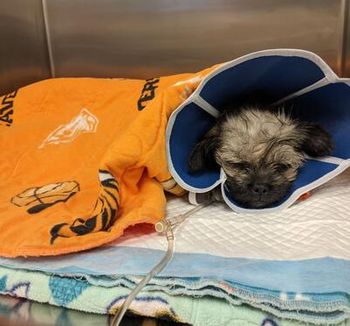
Dogs in the midst of disaster
Search and rescue canines bring comfort, relief to Sandy victims.
A Staten Island veterinarian dodges piles of trash and debris as fast as he can. A victim of Superstorm Sandy, he has no power and the future of his veterinary practice is unknown—and yet he's running to hand a piece a paper to the Massachusetts Urban Search and Rescue Task Force 1 (MA-TF1) team.
>>> Search-and-rescue dog Peewee, a Belgian Malinois, stands at attention while members of the Massachusetts Urban Search and Rescue Task Force 1 team receive their next assignment.
"He'd already given us a business card but then realized he didn't have a working clinic phone. He was racing to give us his cell phone number," says Janet Merrill, DVM, one of the five volunteer dog handlers for MA-TF1 and co-owner of Wilton Animal Hospital in Wilton, N.H. "Here's a veterinarian right in the middle of the Sandy devastation offering to do whatever he could to help us."
Merrill says three more veterinarians offered their services—free of charge—to assist five search-and-rescue dogs on the task force. Two Labrador retrievers (Koda and Phedra), two Belgian Malinois (Peewee and Chai) and one Dutch shepherd (Kairu) traveled with 80 MA-TF1 volunteers to Massachusetts, Connecticut and New York from Oct. 29 to Nov. 3 to help in the Superstorm Sandy relief effort. Most of the victims had already evacuated or been accounted for by the time they arrived. However, that didn't stop the handlers and dogs from taking different shifts and traveling door-to-door, making sure everyone in the area was safe with supplies.
"We targeted homes that were one story because the water was chest deep in some places. You could see water lines on many of the houses," Merrill says. "Other houses looked like fallen Pick-Up Sticks—that's the best way I can describe it."
The highly trained dogs went over, under and through spaces where humans simply couldn't go. Merrill says it takes very special dogs to do this kind of work—they have to be tremendous athletes but they also have to have tremendous courage. She says they have to venture into dangerous, unstable areas that would be scary for most dogs—not to mention people.
"One of the FEMA folks put it best. She said, 'The Urban Search and Rescue (US&R) dogs are the PhDs of the dog world,'" Merrill says. "They stay calm and problem-solve in the midst of absolute chaos. It is that mental character that makes them so special."
Of course, in order for these courageous canines to perform to their full potential, they need proper veterinary care to stay healthy. That's where Lori Gordon, DVM, of Veterinary Surgical Care in Atkinson, N.H., comes in. She says that of the 80 members of MA-TF1, 70 are predetermined by FEMA, and task force leaders choose the remaining 10. The fact that a veterinarian fills one of the optional spots is pretty cool, Gordon says.
"Ten years ago when I started volunteering for MA-TF1, having a veterinarian deployed was pretty unusual," Gordon says. "We've definitely come a long way since then."
Gordon has worked with the dogs for most of their lives and knows their physical parameters. For example, their temperature can run higher than average and they have extremely low, athletic heart rates—Gordon says all of this is normal for search-and-rescue dogs. During daily exams, she looks for signs of stress and wounds on each dog. On day three of the MA-TF1 deployment, Gordon noticed the dogs were on the edge of dehydration.
"These dogs are very high-drive animals. They get very excited about going to work— this is what they love to do—and so they don't drink enough," Gordon says. "The handlers got their dogs to drink more by either putting some food kibble in their water or offering it more frequently."
>>> "Nobody stands idle on the team," says Lori Gordon, DVM (above). "Iâve shown that Iâm willing to work and do whatever needs to be done."
On this mission, the dogs and their handlers trudged through standing water, mud and debris. Cars were floating in the streets, which meant the dogs could have been exposed to oil, gas and antifreeze. This is why, Gordon says, the dogs were decontaminated at the end of each shift with hot or cold water and Dawn dish soap. If the contamination was minimal, she says the team wiped down the dogs with baby wipes.
"The dogs are bare-footed, bare-faced. They don't have boots or respiratory gear to protect them," Gordon says. "So the HazMat technicians, handlers and I determine as best we can what they've been exposed to and how we need to address it."
The dogs' primary duty is to find live victims, but Gordon says they're much more than a search tool. She says their wagging tails in the midst of devastation provide comfort to victims as well as team members, and are also great PR for the team.
"People love to pet them and all of our dogs are so friendly—they actually have to pass a friendly test," Gordon says. "They love the attention and they bring relief to people in all stages of disaster."
Newsletter
From exam room tips to practice management insights, get trusted veterinary news delivered straight to your inbox—subscribe to dvm360.




